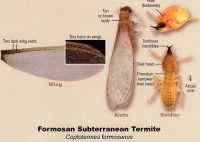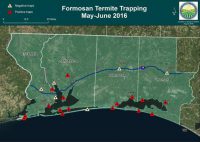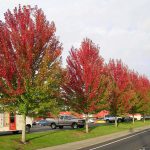by Sheila Dunning | Aug 26, 2016
 The genus Coptotermes contains the largest number of termite pests (28 species) worldwide, with the Formosan subterranean termite, Coptotermes formosansus, being the most widely distributed and most economically important. During the 1960’s it was found in Texas, Louisiana, and South Carolina. The first well-established colony in Florida was reported in 1980.
The genus Coptotermes contains the largest number of termite pests (28 species) worldwide, with the Formosan subterranean termite, Coptotermes formosansus, being the most widely distributed and most economically important. During the 1960’s it was found in Texas, Louisiana, and South Carolina. The first well-established colony in Florida was reported in 1980.
A single colony of Formosan subterranean termite may contain several million termites that forage up to 300 feet in soil. Once established, the Formosan subterranean termite has never been eradicated from an area. Therefore, monitoring of movement of the species is critical. Beginning in 2015, the Florida Department of Agriculture of Consumer Science (FDACS) began trapping the alates. Termites have three primary castes: the reproductive, soldiers, and workers. Within the reproductive caste, the young females, referred to as alates, are the ones that leave the colony. They are able to form wings and seek new areas to become established. Dispersal flights or “swarms” are massive and begin at dusk on calm and humid evenings from April to July. Alates are attracted to lights.
The objective of the FDACS Formosan Termite Alate project is to trap alates throughout the four most western counties of the Panhandle during their major swarm season in May and June, which is the time they are most active in that part of Florida. Trapped alates were counted on a weekly basis to determine peak swarming weeks. White, gridded 7”x 4” sticky card attached to 6’ stakes are placed under strong, predetermined street lights. Twenty-two trap locations were selected, each representing a key Panhandle community with at least one location North of I-10 within each of the four counties.
In 2016, sixteen out of the 22 traps were positive for Formosan termite alates throughout the four Panhandle counties. Formosan alates were caught during 7 of the 8 weeks of trapping. The largest spike in numbers trapped was during the week of May 8th. A subsequent swarming spike occurred during the week of May 22nd. Trap locations that were positive in 2016 and not 2015 included Pensacola Beach, Destin, Blue Mountain Beach, Okaloosa Island and Choctaw Beach. The project will be continued each year in order to determine some of the problem areas.
For more information go to:
by Sheila Dunning | Aug 26, 2016
 Red Maples are among the most frequently planted urban trees. Many of its features, especially its leaves are quite variable in form. Its flowers, petioles, twigs and seeds are all red to varying degrees. But, it is best known for its brilliant deep scarlet foliage in autumn. Red Maple is adaptable to a wide range of site conditions, perhaps more so than any other tree in eastern North America. It can be found growing in swamps, on poor dry soils, and most anywhere in between. However, the tree health and appearance decreases when trees have more impervious surfaces around them.
Red Maples are among the most frequently planted urban trees. Many of its features, especially its leaves are quite variable in form. Its flowers, petioles, twigs and seeds are all red to varying degrees. But, it is best known for its brilliant deep scarlet foliage in autumn. Red Maple is adaptable to a wide range of site conditions, perhaps more so than any other tree in eastern North America. It can be found growing in swamps, on poor dry soils, and most anywhere in between. However, the tree health and appearance decreases when trees have more impervious surfaces around them.
North Carolina State University research has developed the impervious surface threshold (http://content.ces.ncsu.edu/impervious-surface-threshold-for-sustainable-urban-tree-planting-and-landscaping-design) which can be used to identify planting sites where Red Maple will thrive. Landscape architects, urban planners, arborists, landscapers, and other professionals can use these impervious surface thresholds to reduce Red Maple management and replacement costs.
Trees surrounded by less than 33% impervious surface cover will most likely be in good or excellent condition. Trees surrounded by 33%-66% are likely to be in fair condition. Trees surrounded by 67% or more tend to be in poor condition. Impervious surface cover can be measured by using the “Pace to Plant” technique.
The “Pace to Plant” technique is a tool to quickly and accurately quantify the amount of impervious surface surrounding a tree or planting site. Begin by standing at the planting site and identify the closest impervious surface edge. Take 25 steps at 45⁰ to the nearest impervious edge, counting only the steps that land on the impervious surface. Then, return to the identified planting site and begin walking 25 steps in the opposite direction. Again, only count the steps that fall onto impervious surface. If you encounter a building or wall, count the remainder of the steps as impervious. One more time, return to the starting planting site. This time turn 90° and begin walking 25 steps and count the steps that fall onto impervious surface. Finally, turn around and go back to the planting site and begin walking in the opposite direction for 25 steps. This will be the fourth time that steps falling onto the impervious surface are counted. Having walked in four directions located 90° from each other, completing an “X” through the planting site, the transect is final with a total of 100 steps have been taken. By totaling the number of steps that fall onto impervious surfaces the percentage of the surrounding ground area can be determined. For example, if the total number of steps falling on impervious surface is 65 (out of the potentially 100 steps), the percentage of impervious surface is 65%. Using the established criteria, the site would not be suitable for planting a Red Maple.
While North Carolina State has only researched the Red Maple tree species, the “Pace to Plant” technique could be used to determine suitable sites for many different trees being considered for commercial urban planting.
By evaluating the impervious surface restrictions, better tree species selection may be possible. If the right tree for the right place is chosen well, stress to urban trees, including pest infestations, can be reduced.
 The genus Coptotermes contains the largest number of termite pests (28 species) worldwide, with the Formosan subterranean termite, Coptotermes formosansus, being the most widely distributed and most economically important. During the 1960’s it was found in Texas, Louisiana, and South Carolina. The first well-established colony in Florida was reported in 1980.
The genus Coptotermes contains the largest number of termite pests (28 species) worldwide, with the Formosan subterranean termite, Coptotermes formosansus, being the most widely distributed and most economically important. During the 1960’s it was found in Texas, Louisiana, and South Carolina. The first well-established colony in Florida was reported in 1980.
 Red Maples are among the most frequently planted urban trees. Many of its features, especially its leaves are quite variable in form. Its flowers, petioles, twigs and seeds are all red to varying degrees. But, it is best known for its brilliant deep scarlet foliage in autumn. Red Maple is adaptable to a wide range of site conditions, perhaps more so than any other tree in eastern North America. It can be found growing in swamps, on poor dry soils, and most anywhere in between. However, the tree health and appearance decreases when trees have more impervious surfaces around them.
Red Maples are among the most frequently planted urban trees. Many of its features, especially its leaves are quite variable in form. Its flowers, petioles, twigs and seeds are all red to varying degrees. But, it is best known for its brilliant deep scarlet foliage in autumn. Red Maple is adaptable to a wide range of site conditions, perhaps more so than any other tree in eastern North America. It can be found growing in swamps, on poor dry soils, and most anywhere in between. However, the tree health and appearance decreases when trees have more impervious surfaces around them.